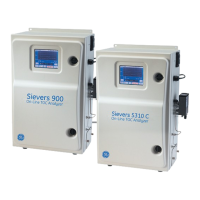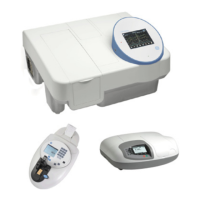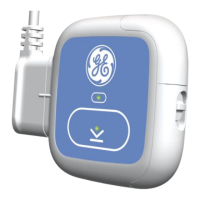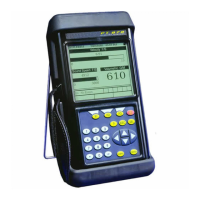GE Analytical Instruments ©2010 96 of 226 DLM 74001-04 Rev. A
Chapter 4: Basic Analyzer Operation
If you activate the conductivity feature, note that the Main screen will not automatically display conductivity
values. See “Changing the Display Mode” on page 90 for instructions on changing the data that display on the
Main screen.
Basic Hardware Operation Issues
Opening the Analyzer Case
The Analyzer case is easy to open to facilitate routine maintenance tasks.
Open the Analyzer front panel by turning the two latches and swinging the panel door to the left; you will need to
unlock the bottom latch with the key provided in the Analyzer’s accessories kit. When closing the front panel, be
sure to firmly close both of the latches. In addition, some subsystems inside the Analyzer, such as the electrical
enclosure at the top, are protected by covers. Remove the covers by loosening the captive screws with a Phillips
screwdriver, and always make sure the Analyzer is powered off and the power is disconnected before removing
the covers. When replacing the covers, be sure to seat the cover securely and evenly.
The Touch Screen
The Analyzer’s touch screen is a quarter-VGA color LCD. The operator’s finger is optimal for interacting with the
display. To avoid scratching the display, do not use pens or pencils to press buttons.
Recommended Operational State
To assure optimal performance across the operating range, the Analyzer should remain powered On in the idle
state when not in use. This will allow the measurement components and other subsystems to maintain their
equilibrium with the ambient environment. If the Analyzer cannot be left on between uses, allow the it to re-
equilibrate for 90 minutes prior to beginning analysis. Failure to do so may compromise the Analyzer's initial
results. This could mean a decrease in the instrument's accuracy, an increased likelihood of obtaining negative
TOC values, or an increase in the standard deviation values.
The iOS System
GE Analytical Instrument offers three inlet systems for use with the Sievers 500 RL On-Line TOC Analyzer: a
sample inlet block for dedicated on-line analysis, a standard Integrated On-Line Sampling (iOS) System, with one
vial port, and a Super iOS, with four vial ports. Both iOS systems provide a convenient sample inlet for on-line
sample sources and standards in vials. You do not need to change the inlet configuration when switching
analysis from on-line mode to sample from vials. If you have a standard iOS System, slide the iOS System door
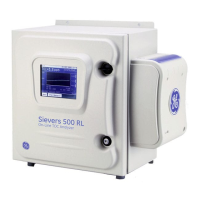
